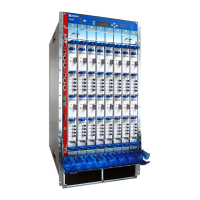T640 System Architecture Description
The router architecture cleanly separates control operations from packet forwarding
operations. This design eliminates processing and traffic bottlenecks, permitting the
router to achieve high performance. Control operations in the router are performed by
the host subsystem, which runs Junos OS to handle routing protocols, traffic engineering,
policy, policing, monitoring, and configuration management. Forwarding operations in
the router are performed by the Packet Forwarding Engines, which consist of hardware,
including ASICs, designed by Juniper Networks.
The T640 Core Router has two main architectural components:
•
Routing Engine—This component provides Layer 3 routing services and network
management.
•
Packet Forwarding Engines—These high-performance, ASIC-based components provide
Layer 2 and Layer 3 packet switching, route lookups, and packet forwarding.
The Routing Engine and the Packet Forwarding Engines perform their primary tasks
independently, although they constantly communicate through multiple 100-Mbps links.
This arrangement streamlines forwarding and routing control and runs Internet-scale
backbone networks at high speeds. Figure 1 on page 5 shows the relationship between
the Routing Engine and the Packet Forwarding Engines.
Figure 1: Router Architecture
Related
Documentation
T640 Chassis Description on page 15•
T640 Routing Engine Functions
The Routing Engine handles all routing protocol processes, as well as the software
processes that control the router's interfaces, the chassis components, system
management, and user access to the router. These routing and software processes run
on top of a kernel that interacts with the Packet Forwarding Engine.
The Routing Engine includes the functions and features:
5Copyright © 2017, Juniper Networks, Inc.
Chapter 1: System Overview and Architecture

